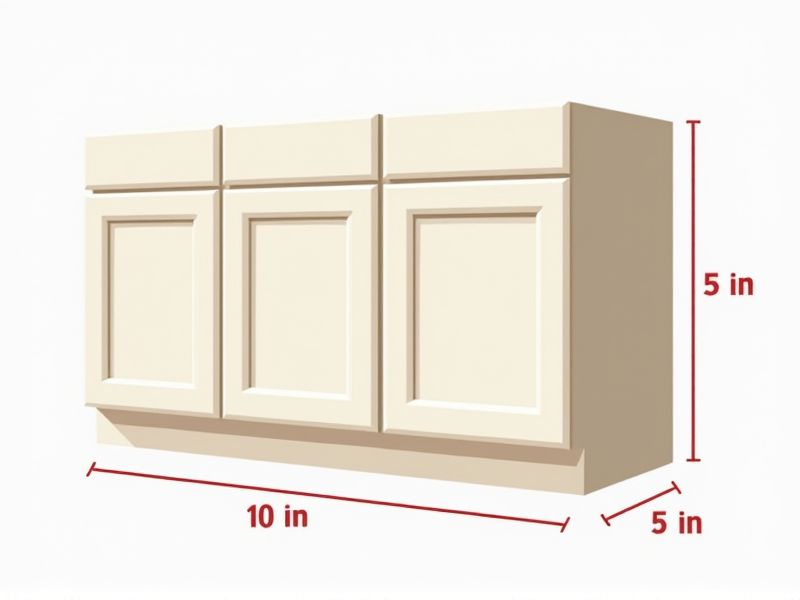
Understanding the standard dimensions of kitchen cabinets is essential when planning a functional kitchen layout. Base cabinets typically stand 34.5 inches high and are 24 inches deep, providing a strong foundation for countertops and ample storage for pots and pans. Wall cabinets generally have a depth of 12 inches and heights ranging from 30 to 42 inches, which allows you to customize the space above your counters. Knowing these measurements helps ensure your kitchen appliances fit seamlessly and enables efficient organization and workflow.
Base Cabinet Height
Base cabinet height typically measures 34.5 inches, providing an ergonomic workspace for most users. This standard height accommodates kitchen countertops, which generally add an additional 1.5 inches, totaling around 36 inches. Custom heights are available, with options ranging from 30 inches to 42 inches, allowing for greater flexibility based on personal preference and user needs. When designing your kitchen, consider incorporating adjustable shelving within the cabinets to maximize storage efficiency.
Base Cabinet Depth
The standard depth for base kitchen cabinets typically measures 24 inches, providing ample space for storage and functionality. This depth allows for a comfortable working area, accommodating standard kitchen appliances and ensuring easy access to items placed within. When planning your kitchen layout, consider the cabinet height, usually ranging from 32 to 36 inches, to achieve an ergonomic design. A well-organized base cabinet system enhances both aesthetics and efficiency in any modern kitchen.
Wall Cabinet Height
The standard height for wall kitchen cabinets typically ranges from 30 to 42 inches, accommodating various ceiling heights and user preferences. For a more customized solution, consider installing cabinets at 36 inches for easy access or up to 42 inches to utilize vertical space effectively. You may also want to install these cabinets 18 inches above the countertop to provide ample working area while maintaining aesthetic appeal. Ensuring the right wall cabinet height can enhance both functionality and visual harmony in your kitchen design.
Wall Cabinet Depth
The standard depth for wall kitchen cabinets typically measures 12 inches, providing ample space for storing various kitchen items while maintaining a streamlined appearance. This depth allows for efficient use of vertical space, essential for maximizing storage in smaller kitchens. When paired with base cabinets that typically have a depth of 24 inches, the overall kitchen layout creates an ergonomic cooking environment. You can enhance functionality by choosing cabinets with adjustable shelving to accommodate various sizes of dishware or pantry items.
Toe Kick Height
The standard toe kick height for kitchen cabinets is typically 3 inches, designed to provide comfort and functionality while standing at the countertop. This space allows for easy foot placement and helps minimize leg strain during meal preparation. Many manufacturers also offer customization, allowing you to increase or decrease the height based on individual preferences or specific kitchen layouts. Ensuring the correct toe kick height in your kitchen can enhance both aesthetics and ergonomics, making a significant difference in your cooking experience.
Upper Cabinet Width
Upper kitchen cabinets typically have a standard width of 30 to 36 inches, which offers ample space for storage and accessibility. Most homeowners prefer a height of 18 inches between the countertop and the bottom of the upper cabinets, allowing for easy reach and use of the kitchen workspace. It's essential to consider the depth of these cabinets, which generally ranges from 12 to 15 inches, optimizing your kitchen's organization without sacrificing walk space. When planning your kitchen remodel, ensure that the upper cabinet widths align with your layout for a harmonious and functional design.
Countertop Overhang
The standard countertop overhang for kitchen cabinets typically measures 1 to 1.5 inches, providing functional space for seating and enhancing aesthetic appeal. This overhang allows for comfortable legroom for diners while also accommodating various countertop materials, which can range from granite to quartz. When designing your kitchen, consider the total depth of your cabinets, which averages 24 inches, to ensure that the overhang complements the overall layout. A well-planned countertop overhang can also improve the workflow in your kitchen by facilitating easy access to cooking and prep areas.
Island Cabinet Dimensions
Standard kitchen island cabinet dimensions typically range from 4 to 8 feet in length, with a standard depth of 24 inches. The height of these cabinets generally aligns with the standard countertop height, which is 36 inches. When designing your kitchen island, consider a minimum clearance space of 36 to 42 inches around the island for optimal movement. Including storage solutions like drawers and shelving in island cabinets can enhance functionality and maximize the utility of this kitchen feature.
Pantry Cabinet Depth
Kitchen cabinets typically feature a standard pantry cabinet depth of 24 inches, providing ample storage space for bulky items. Most designs offer adjustable shelves to maximize organization, accommodating various container sizes and enhancing accessibility. A well-constructed pantry cabinet should incorporate durable materials, such as plywood or solid wood, ensuring longevity and resistance to wear. When selecting your pantry cabinet, consider options with built-in features like pull-out shelves or soft-close hinges for improved functionality and ease of use.
Cabinet Opening Clearance
Cabinet opening clearance typically measures 24 to 36 inches in width to ensure easy access to cooking essentials. It is essential to maintain a minimum of 30 inches from the floor to the countertop for ergonomic efficiency. Depending on your kitchen layout, consider door swing space, which often requires an additional 18 to 24 inches for unobstructed operation. Proper clearance not only enhances functionality but also ensures safety by preventing overcrowding around cooking areas.
